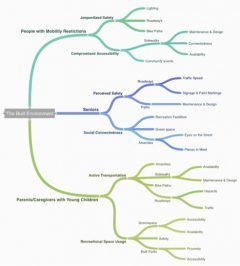The Most Desired Changes
Among the total sample, the top 3 features needing improvement were
- Biking and Walking Paths
- Public green space and scenic features
- Sidewalk quality
Among the subpopulations, it’s interesting to note that the top two features for improvement are also present among the list for the total sample. Where it they differ is crosswalks, which made the top 3 list among the sub-population groups.
|
Sub-populations |
||||
| Rank | Survey Sample | Seniors | Parents | Mobility Restrictions |
| 1 | Bike/walking paths | Bike/walking paths | Bike/walking paths | Sidewalk quality |
| 2 | Sidewalk quality | Sidewalk quality | Sidewalk quality | Bike/walking paths |
| 3 | Public green space & scenic features | Crosswalks | Crosswalks | Crosswalks |
We used the findings from focus groups to identify why members of our subpopulations felt that these features needed changing. Analyses of the focus group data revealed themes of built features that influenced safety, accessibility, social connectedness, and active transportation.

Specifically, sidewalk design (e.g. sloped sidewalks), sidewalk maintenance (e.g. snow removal), and neighbourhoods which facilitate year-round active transportation (cycling, walking, or public transit) were major concerns for all three subgroups. Seniors participants highlighted proximity to resources as facilitating social connectedness, while parents indicated well maintained streets in addition to proximity to resources as necessary for facilitating year-round active transportation. Not surprisingly, poor street maintenance was a major barrier to safety and accessibility for persons with mobility restrictions.
The built environment features most frequently indicated by all participants as requiring improvement included, biking/walking paths, sidewalk quality, and green space and scenic features. This provides key areas for consideration by public health and urban planners, and policy makers during the development of inclusive and health-promoting neighbourhoods.